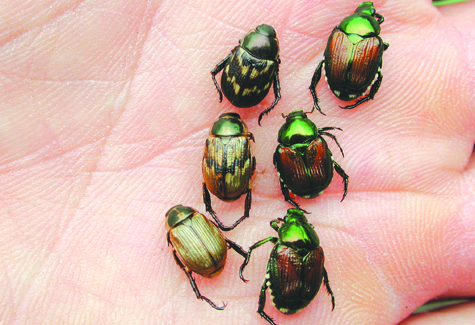Experts say Japanese beetle populations dying; Oriental beetles on the rise

Oriental beetles have been slowly taking over their Japanese cousin’s territory, experts say.
Anecdotal evidence has shown that the Japanese beetle’s numbers have steadily declined over the last five years, said Daniel Gilrein, an entomologist with the Cornell Cooperative Extension in Riverhead. Complaints about the bug, which feast on fleshy, fuzzy leaves, have fallen, and Mr. Gilrein’s informal surveys have yielded very few of the beetles in their infant stage in turf and lawns, he said.
“I recall in the late ‘80s, early 90s, we would see Linden trees completely defoliated by them,” Mr. Gilrein said. “They eat the areas between the veins, and you get shreds of leaves left behind.”
But Mr. Gilrein has also noticed that the aggressive Oriental beetle has become dominant. Oriental beetles do the most damage underground, rarely eating leaves like the Japanese do, he said. Instead, they nibble on the roots of grass, rhododendron, Junipers, hemlock and other container-grown plants.
“They’re worse in some ways,” Mr. Gilrein said. “They have a wider host range, and they go to more places.”
Oriental beetles are currently in their infant “grub” stage, feeding on roots, Mr. Gilrein said. Starting in the fall, homeowners, golf course maintenance crews, municipality parks department staff – anyone with a wide swath of turf to maintain – could start to see dead spots in grass.
Damage can be so bad, that the turf can be lifted from the ground like a rug off the floor, he said. Underneath, there will be at least seven to eight grub per square foot, an unsightly shock as the just-hatched insects look almost like maggots. Japanese beetle grub can do similar damage, but Mr. Gilrein is now working on methods to control Oriental beetles.
When DeLalio Sod Farms in Calverton deals with grub of any species, they’re usually on the periphery of the crop, said Terry Dugan, a turf expert and seed manager at the business.
Mr. Dugan treats the problem with Dylox, an insecticide. David Vater, a member of the New York State Arborists and a lawn consultant in Calverton, said at around this time of the year, professionals can determine whether or not grub damage will be severe.
He tackles grub with insecticides, too.
“Insecticide usage is viewed by some as taboo but it’s a necessary action,” he said.
For clients with environmental concerns, he has used milky spore, a bacteria that kills the grub.
But, Oriental beetles will most likely survive through a milky spore application, a change that means pest control professionals may have to rethink their tactics. Mr. Gilrein and other Cornell entomologists are developing a control technique called mating disruption that is specific to the new invader. A pheromone lures in a male Oriental beetle to mate, but the bug ends up repeatedly bumping into the trap, never reproducing.
Mr. Gilrein has been experimenting with this control method in a few East End nurseries, and plans to try it eventually on fields and golf courses.
Container plants – one of Oriental beetles’ preferred snacks – are for sale at Homeside Florist, located on the corner of Main Road and County Road 105 in Riverhead. But nursery owner Ernie Olsen said he has yet to have a beetle infestation, which could damage the product he sells and hurt his business.
“I’ve seen a few,” Mr. Olsen said. “We have a spray schedule but anything can come in from the wind.”
Mr. Olsen has also noticed the decline of Japanese beetles: years ago, he said, he had to spray every week for beetles on his outdoor rose plants. Now, he only sprays biweekly.
A Walking Stick plant outside Darlene Widirstky’s Southold cottage shows the severe damage the remaining Japanese beetles can cause.
Most of the leaves on the miniature tree are eaten through.
Ms. Widirstky, a master gardener and horticulture teacher at the Suffolk County Jail in Riverside, avoids using chemical insecticides to combat the destructive bug, preferring instead to brush the beetles into jars of soapy water. When the Japanese beetle population was at a high point, she collected as many as 100 each day. Now the count is down to a couple each day, she said.
She has not noticed any Oriental beetles in her garden or lawn this summer, though Mr. Gilrein later reminded that they are not as “in-your-face” as Japanese beetles, which sun on plants.
Mr. Gilrein and other Cornell scientists have not been able to pinpoint the reason for the Japanese beetle’s demise. In the Japanese beetle’s heyday, they never studied the factors that kept the bug’s population under control, Mr. Gilrein said. That makes it impossible to learn what has changed since then.
He suspects that because the Oriental beetle eats much more than the Japanese, it’s a stronger, more versatile insect. He anticipates the Oriental beetle will continue to thrive.
“It’s not just a blip, it’s a trend,” Gilrein said.








